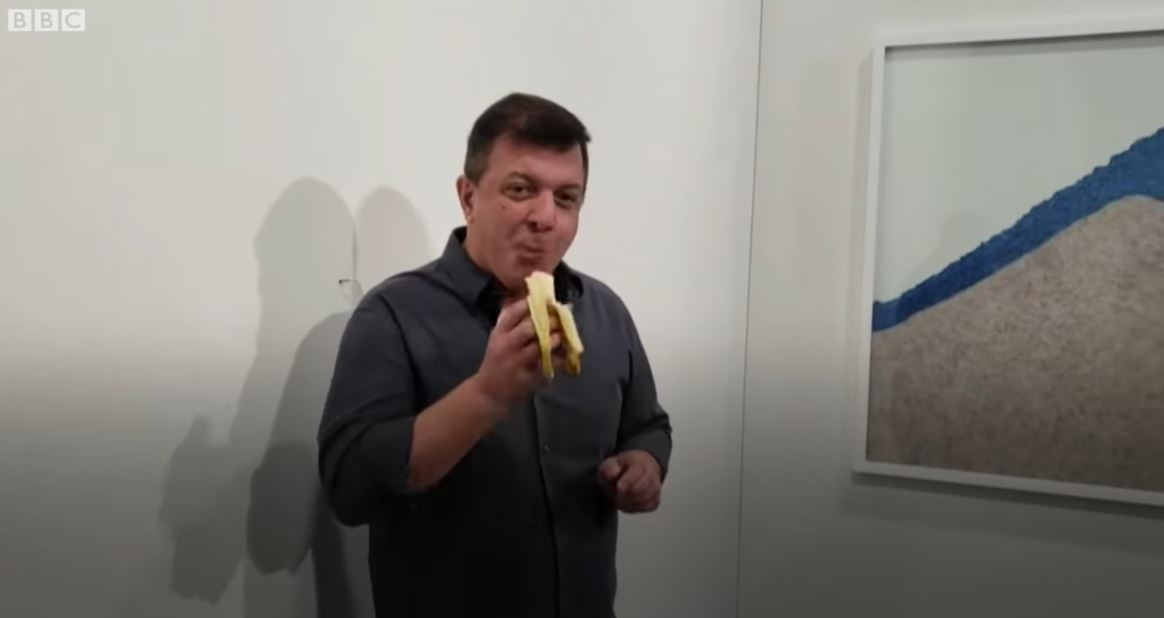Last week, Miami art gallery Art Basel sold, for $120,000, a piece of art composed of a banana duct taped to a wall. At least one other identical piece sold for a similar amount. A third piece was priced at $150,000. The banana used in the display is a real banana, and on Saturday, a performance artist named David Datuna ate some of it.
Datuna’s stunt merely illustrated what everyone should have already known: the value of the artwork had almost nothing to do with the banana itself. Its value came not from the amount of labor that went into it or from the cost of the physical materials involved. A spokeswoman for the museum summed up the real source of the item’s value, noting, “He [Datuna] did not destroy the artwork. The banana is the idea.”
In other words, the people who purchased the art weren’t actually purchasing a banana and tape. The person who purchased the art was buying the opportunity to communicate to peers that he or she was rich enough to throw around $120,000 on a work of art that would soon cease to exist. This was a transaction that involved purchasing status in exchange for money. The banana was only a tiny part of the exchange.
Moreover, the transaction offered the opportunity for the gallery, the art seller, and the art buyer to all further increase their status by being the topic of discussion in countless news articles and discussions in social media. As was surely anticipated by the artists and everyone else in the banana sale, the media could be counted on to act as if this art was something new, outrageous, or exciting. “Art world gone mad,” the New York Post announced on its front page. Hundreds of thousands of commentators in various social media forums chimed in to comment on the matter.
One wonders, however, how many times this shtick can be repeated over and over until people lose interest. Apparently: many times. After all, this sort of art is not a new thing. For decades, avant-garde artists have been using garbage and other found objects to create art. And people with a lot of disposable income have been willing to pay a lot of money for it. It’s all basically an inside joke among rich people. And regular people have the same reaction over and over again.
But there’s absolutely nothing at all that’s shocking, confusing, or incomprehensible from the point of view of sound economics. Transactions like these should only surprise us if we’re still in the thrall of faulty theories of value, such as the idea that goods and services are valued based on how much labor and materials went into them. That’s not true of any good or service. And it’s certainly not true of art.
Is It Garbage or Is It Art?
In fact, two identical items can be valued in two completely different ways simply if the context and description of the objects changes.
According to the Daily Mail, a 2016 study suggests that people value ordinary objects differently depending on what they are told about the objects: “According to the new research, being told that something is art automatically changes our response to it, both on a neural and a behavioural level.”
In this case, researchers in Rotterdam, the Netherlands, told subjects to rate how they valued objects in photographs. When told that those objects were “art” people valued them differently.
In other words, the perceived value of objects could change without any additional labor being added to them, and without any physical changes at all.
The value, it seems, is determined by the viewer, and we’re reminded of Carl Menger’s trailblazing observations about value:
Value is a judgment economizing men make about the importance of the goods at their disposal for the maintenance of their lives and well-being. Hence value does not exist outside the consciousness of men.
One moment the viewer may think he’s looking at garbage, which he has likely learned is of little value. When told that said junk is really “art,” the entire situation changes. (Of course, we would need to see their preferences put into real action via economic exchange to know their preferences for sure.)
The change, as both Menger and Mises understood it, is brought about not by changes to the object itself, but by changes in context and in the subjective valuation of the viewer.
A glass of water’s value in a parched desert is different from that of a glass next to a clean river. Indeed, a glass of water displayed in a museum as art — as in the case of Michael Craig-Martin’s “An Oak Tree” — is different from water found in both deserts and along rivers. Similarly, the value of a urinal displayed in a museum as art — as with Marcel Duchamp’s “Fountain” — is different from a physically identical urinal in a restroom.
The Daily Mail article attempts to tie the researchers’ observations to the theories of Immanuel Kant on aesthetics. But, one need know nothing about aesthetics at all to see how this study simply shows us something about economic value: it is, to paraphrase Menger, found in the “consciousness of men.”
And it is largely due to this fact that centrally planning an economy is so impossible. How can a central planner account for enormous changes in perceived value based on little more than being told something is art?
Is a glass of water best utilized on a shelf in a museum, or is it best used for drinking? Maybe water is best used for hydroelectric power? Exactly how much should be used for each purpose?
When discussing the problems of economic calculation in socialism, Mises observed that without the price system, there simply is no way to say that a specific amount of water is best used for drinking instead of being used for modern-art displays. Nor is the fact that people need water for drinking the key to determining the value of water. (See the diamond-water paradox.)
In a functioning market, consumers will engage in exchanges involving water in a way that reflects how much they prefer each use of water to other uses. At some moments, some consumers may prefer to drink it. At other moments, they may prefer to water plants with it. At still other moments, they may want to contemplate an art display composed of little more than a glass of water. The price of water at each time and place will reflect these activities.
Without these price signals, attempting to create a central plan for how each ounce of water should be used is an impossible task.
Do we need to know why people change their views of objects when told they are art? We do not. Indeed, were he here, Mises would perhaps be among the first to remind us that economics need not tell us the mental processes that lead to people preferring different uses for different objects, although we can certainly hazard a guess. It’s unlikely that the buyer of the taped banana bought it because he or she planned to eat it.
But even if we are wrong about the buyer’s motivation, the fact remains that the buyer valued the banana at $120,000 for some reason — and the value was subjective to the buyer.
Similarly, we can’t know for sure why each individual values water for drinking over “art water” or vice versa. And a government planner or regulator — it should be noted — can’t know this either.
—
This article has been republished with permission from Mises Institute.
[Image Credit: YouTube]
















Leave a Comment
Your email address will not be published. Required fields are marked with *